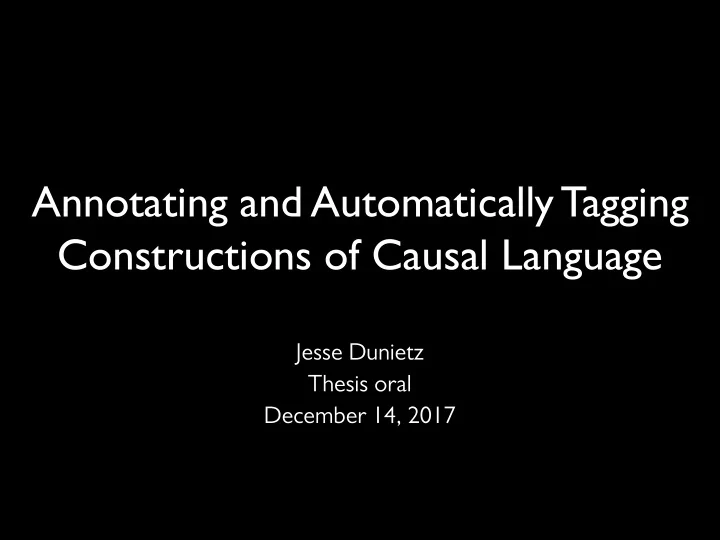

1. Pattern-based 2. Argument 3. Statistical classifier connective discovery identification to filter results from worry from worry I…died I…died your your from from hotel hotel from …called …called me me from 4. Remove duplicate connectives
Causeway-S/Causeway-L: two pattern-based taggers for causal constructions Causeway-S: Syntax-based pipeline i. Causeway-L: Lexical pattern-based pipeline ii.
Causeway-S/Causeway-L: two pattern-based taggers for causal constructions Causeway-S: Syntax-based pipeline i. Causeway-L: Lexical pattern-based pipeline ii.
each construction is treated as a partially-fixed parse tree fragment.
each construction is treated as a partially-fixed parse tree fragment.
each construction is treated as a partially-fixed parse tree fragment. advcl mark because/IN
each construction is treated as a partially-fixed parse tree fragment. advcl mark because/IN
TRegex patterns are extracted in training, and matched at test time. (/^because_[0-9]+$/ <2 /^IN.*/ <1 mark advcl because > (/.*_[0-9]+/ <1 advcl mark > (/.*_[0-9]+/))) because/IN
TRegex patterns are extracted in training, and matched at test time. (/^because_[0-9]+$/ <2 /^IN.*/ <1 mark advcl because > (/.*_[0-9]+/ <1 advcl mark > (/.*_[0-9]+/))) because/IN + because TRegex 1 (/^because_[0-9]+$/ <2 /^IN.*/ <1 mark > (/.*_[0-9]+/ <1 advcl > (/.*_[0-9]+/)))
Argument heads are expanded to include most dependents. worry/VBP care/VBP
Argument heads are expanded to include most dependents. worry/VBP care/VBP
1. Causeway-S/Causeway-L: two simple systems for tagging causal constructions Causeway-S: Syntax-based pipeline i. Causeway-L: Lexical pattern-based pipeline ii.
1. Causeway-S/Causeway-L: two simple systems for tagging causal constructions Causeway-S: Syntax-based pipeline i. Causeway-L: Lexical pattern-based pipeline ii.
constructions are matched by regular expressions over word lemmas. because (ˆ | )([ \ S]+ )+?(because/IN) ([ \ S]+ )+? because + regex (ˆ | )([ \ S]+ )+?(because/IN) ([ \ S]+ )+?
Arguments are labeled by a conditional random field. … … � � � � � ��� � ��� ��� • • •
Both approaches use a soft vote of three classifiers as a filter.
Both approaches use a soft vote of three classifiers as a filter. � �
Both approaches use a soft vote of three classifiers as a filter. � �
Both approaches use a soft vote of three classifiers as a filter. Example classifier features : • • • • • •
Our benchmark is a dependency path memorization heuristic. 27/ 4 0 / 8 14 / 1 …
Connective discovery 11.5% 51.7% 13.4% 50.8% 31.6% 54.9% 54.6%
Connective discovery: Causeway outperforms the benchmark by ~20 points. 11.5% 51.7% 13.4% 50.8% 31.6% 54.9% 54.6%
Performance improves even more when Causeway is combined with the benchmark. 11.5% 51.7% 13.4% 50.8% 31.6% 54.9% 54.5%
The first stage gets high recall & low precision 11.5% 51.7% 13.4% 50.8% 31.6% 54.9% 54.6%
The first stage gets high recall & low precision, but the filters balance them out for a better F 1 . 11.5% 51.7% 13.4% 50.8% 31.6% 54.9% 54.6%
Argument identification is passable given connective discovery, though effects are harder than causes.
Argument identification is passable given connective discovery, though effects are harder than causes.
T oday’s talk: The BECAUSE annotation scheme & corpus of causal language Causeway-L/Causeway-S: two pattern-based taggers for causal constructions DeepCx: a neural, transition-based tagger for causal constructions
T oday’s talk: The BECAUSE annotation scheme & corpus of causal language Causeway-L/Causeway-S: two pattern-based taggers for causal constructions DeepCx: a neural, transition-based tagger for causal constructions
Transition-based tagging builds a complex output structure using a sequence of simple operations.
The DeepCx transition scheme
The DeepCx transition scheme
The DeepCx transition scheme
The DeepCx transition scheme Tagger state
The DeepCx transition scheme N O - C ONN Tagger state
Recommend
More recommend